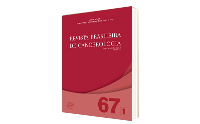Placement of Inferior Vena Cava Filter: Clinical and Prognostic Characteristics of Cancer Patients at INCA
DOI:
https://doi.org/10.32635/2176-9745.RBC.2021v67n1.841Keywords:
Vena Cava Filters/adverse effects, Neoplasms, Venous Thromboembolism, Survival Analysis, DeathAbstract
Introduction: Venous thromboembolism is a potentially fatal condition and frequent in oncologic patients. Quite often full anticoagulation is unfeasible, and placement of an inferior vena cava (IVC) filter becomes an option. Clinical indication, however, is controversial and expensive. Objective: To describe the demographic, clinical and epidemiological characteristics of oncologic patients submitted to IVC filter placement and their impact on global survival. Method: Retrospective cohort study with patients undergoing cancer treatment at INCA submitted to IVC filter placement from January 2015 to April 2017. Time between cancer diagnoses and death from any cause was considered for the analysis of the global 5-years survival. Descriptive analysis, survival estimates (Kaplan-Meyer) and Cox regression were performed. Results: 74 patients with a mean age of 54 (+15) years were included. Most of them had gynecological (52.7%) and digestive (20.3%) tumors. The median time between cancer diagnosis and IVC filter placement was 3.48 months (0-203). In the follow-up, 40 deaths (54.1%) were observed with a median time of 25 months (95% CI; 1.76 to 47.32). In the adjusted analysis, 5.63 times greater risk of death was verified in patients with IVC filter placement within six months after cancer diagnosis (HR=4.99; 95% CI; 2.20-11.33; p<0.001), and 2.47 times greater risk among those who did not do it at pre-operation (HR=2.47; 95% CI; 1.08-5.66; p=0.032). Conclusion: IVC filter placement was performed more frequently in patients with gynecological tumors and in until six months after cancer diagnosis was associated with increased risk of death.





